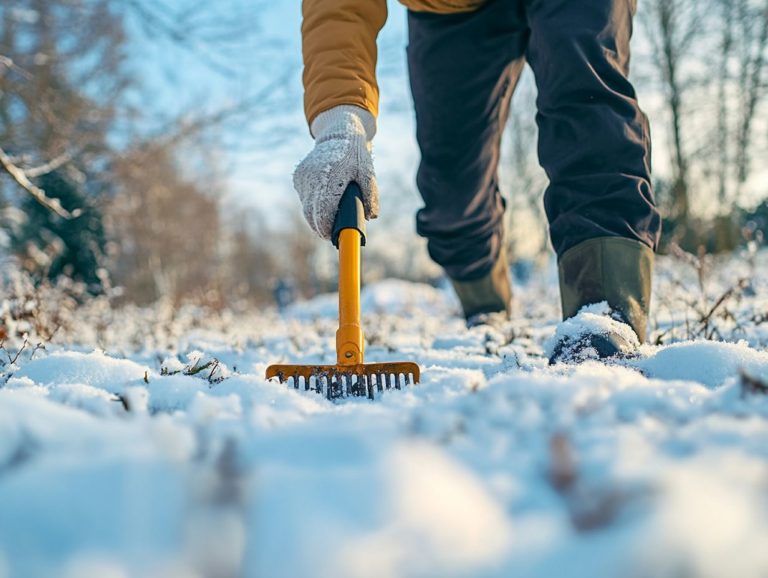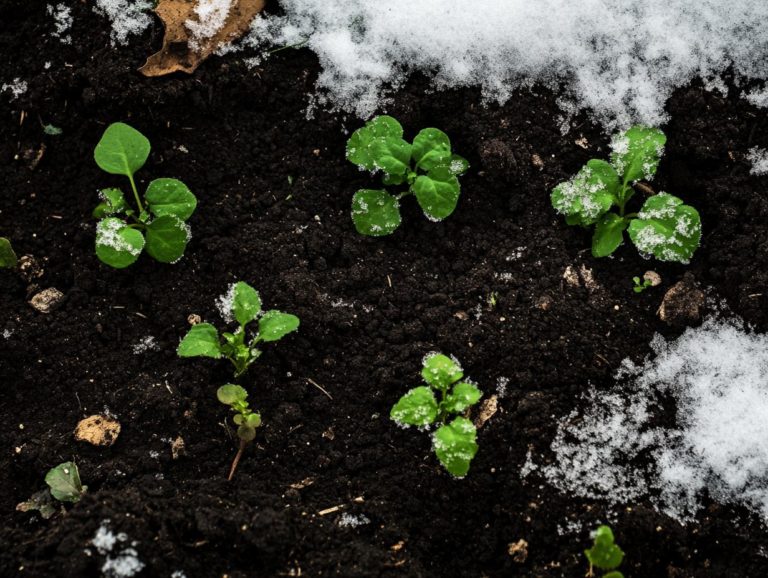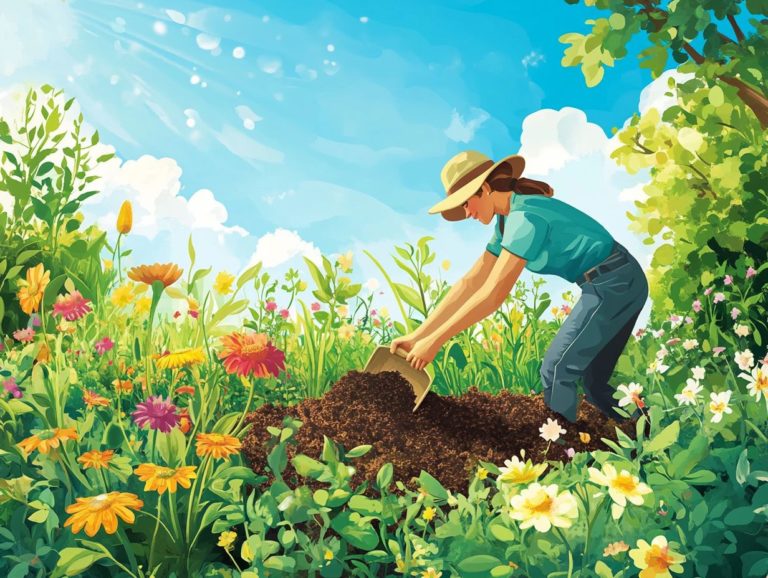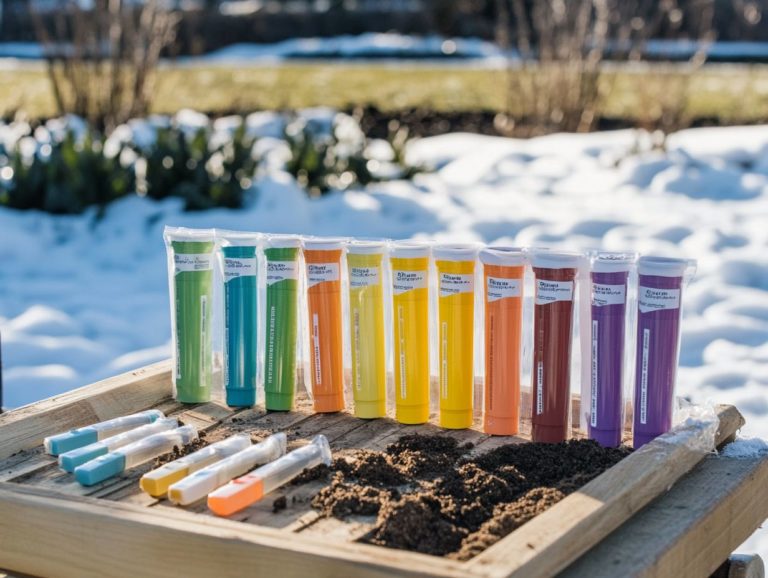Best Practices for Soil Preparation in Winter
Soil preparation during winter is a crucial yet frequently overlooked part of gardening and agriculture. As temperatures dip, understanding the unique benefits of winter soil care can significantly enhance your plants’ growth and vitality when spring arrives.
This article explores essential factors to consider, effective steps for preparing your soil, and the tools and techniques that yield optimal results. It highlights common pitfalls to avoid and offers valuable tips for maintaining soil health throughout the colder months.
Are you ready to give your garden the best winter care possible? Let s dive into winter soil care and make your garden thrive!
Contents
Key Takeaways:

- Winter soil preparation is vital for promoting healthy plant growth and maximizing yields in the spring.
- Consider your climate and soil type before preparing soil in winter, using the right tools and techniques for the cold weather.
- Avoid common mistakes by clearing and conditioning the soil, adding nutrients, and protecting it from harsh conditions.
The Importance of Soil Preparation
Soil preparation is essential for optimizing plant health and growth. It provides a solid foundation for crops to thrive, especially during those harsh winter months when the ground can become inhospitable. For more insights, consider preparing your planting beds for winter.
Focus on improving soil structure. This will help make more nutrients available through techniques such as composting and incorporating organic materials. By doing this, your vegetables, berries, and perennials will not only survive but truly flourish in the upcoming seasons.
Experts like Catherine Boeckmann from The Old Farmer s Almanac and Lisa Kubik from the Soil Health Partnership emphasize the long-term benefits of these practices, making them worth your attention.
Benefits for Plant Growth and Health
The benefits of effective soil preparation extend beyond improving plant growth; they enhance the overall health of the ecosystem. By using proper soil preparation techniques, you can unlock many advantages, including improved access to nutrients that supports robust plant development.
For instance, incorporating cover crops enriches the soil with organic materials, creating a nutrient-rich environment. When soil is well-prepared, it exhibits better water retention, which is crucial for maintaining moisture levels during dry spells. This conserves water and encourages deeper root growth.
Healthy soil also boosts resistance to pests and diseases, allowing your plants to thrive with minimal chemical interventions. Ultimately, this creates a more resilient agricultural system, benefiting both you and the environment.
Factors to Consider Before Winter
Before winter arrives, consider several crucial factors to ensure your garden remains healthy and productive come spring. It’s essential to understand the specific climate conditions and soil type in your area, as these will significantly influence the best practices for maintaining soil health. For expert advice, check out these cold-climate gardening soil preparation tips to prepare your crops effectively.
Elements like moisture retention, temperature fluctuations, and the likelihood of frost will guide how you approach soil preparation and care during this season.
Climate and Soil Type
Understanding the interplay between climate and soil type is essential for effective garden maintenance, especially with winter on the horizon.
Different climatic conditions can significantly influence soil properties, impacting crop development throughout the growing season. For example, while sandy soils drain quickly, clay soils retain moisture, making them more vulnerable to frost heave during winter.
Seasonal changes shift moisture levels and affect nutrient availability, requiring careful preparation. Adapt your practices accordingly like applying mulch to insulate the soil and retain moisture during colder months to ensure the soil remains balanced for future plant growth and resilient against winter stresses.
Steps for Preparing Soil in Winter

Get ready to transform your garden! Preparing your soil for winter is all about maximizing fertility and setting the stage for the upcoming growing season.
The process starts with clearing away debris, followed by conditioning the soil using effective techniques.
Strategically add essential nutrients and additives that improve soil quality, vital for fostering a thriving garden. By following these steps, you pave the way for healthier crops and enhanced yields once winter gives way to spring.
Clearing and Conditioning
Clearing and conditioning the soil are essential steps in winter preparation that can significantly impact your garden’s health come spring, especially when following the best practices for winter fertilization.
Efficiently remove debris like fallen leaves, branches, and weeds to create an ideal environment for a flourishing ecosystem.
Soil conditioning allows you to incorporate organic materials such as mulch, compost, and well-rotted manure. These additions improve soil structure, making it easier for roots to dive deep, while boosting fertility with vital nutrients.
Organic mulch serves as a protective shield, regulating moisture levels and keeping weeds at bay. This fosters a rich habitat for beneficial microorganisms, creating a healthier garden overall.
Adding Nutrients and Amendments
Adding the right nutrients and amendments to your soil is crucial for enhancing its quality and ensuring a bountiful harvest.
A diverse array of nutrients and organic materials can significantly improve soil health. For instance, incorporating compost introduces beneficial microorganisms that break down organic matter and release essential nutrients over time.
Organic materials like aged manure and leaf mold enhance soil structure and boost moisture retention, fostering healthy root development.
Amendments such as bone meal provide phosphorus, vital for strong root systems, while green manures like clover enrich nitrogen levels.
Carefully select the right mix of these beneficial substances to cultivate a thriving environment that promotes robust plant growth and maximizes your yield.
Tools and Techniques for Winter Soil Preparation
Equip yourself with the right tools and techniques for effective soil preparation during winter by following best practices for winter gardening. This ensures your garden remains healthy and productive.
Tools like tillers and shovels aid in soil conditioning, while layering organic mulch protects the soil from harsh weather conditions.
Utilize these resources wisely to optimize your gardening efforts for maximum impact.
Recommended Tools and Equipment
Having the right tools can dramatically elevate the effectiveness of your soil preparation efforts.
Investing in quality tools is crucial for maximizing the benefits of organic mulch and compost. A garden fork is essential for turning existing soil and incorporating compost evenly, while a trowel is perfect for initial soil aeration and digging small planting holes.
A sturdy rake is vital for leveling the surface and spreading mulch uniformly, effectively preventing uneven moisture retention.
Don t overlook a wheelbarrow or cart, which simplifies transporting heavy compost materials, making your process more efficient.
By selecting the right tools, you enhance soil structure, paving the way for healthier plants and better yields.
Effective Techniques for Cold Weather
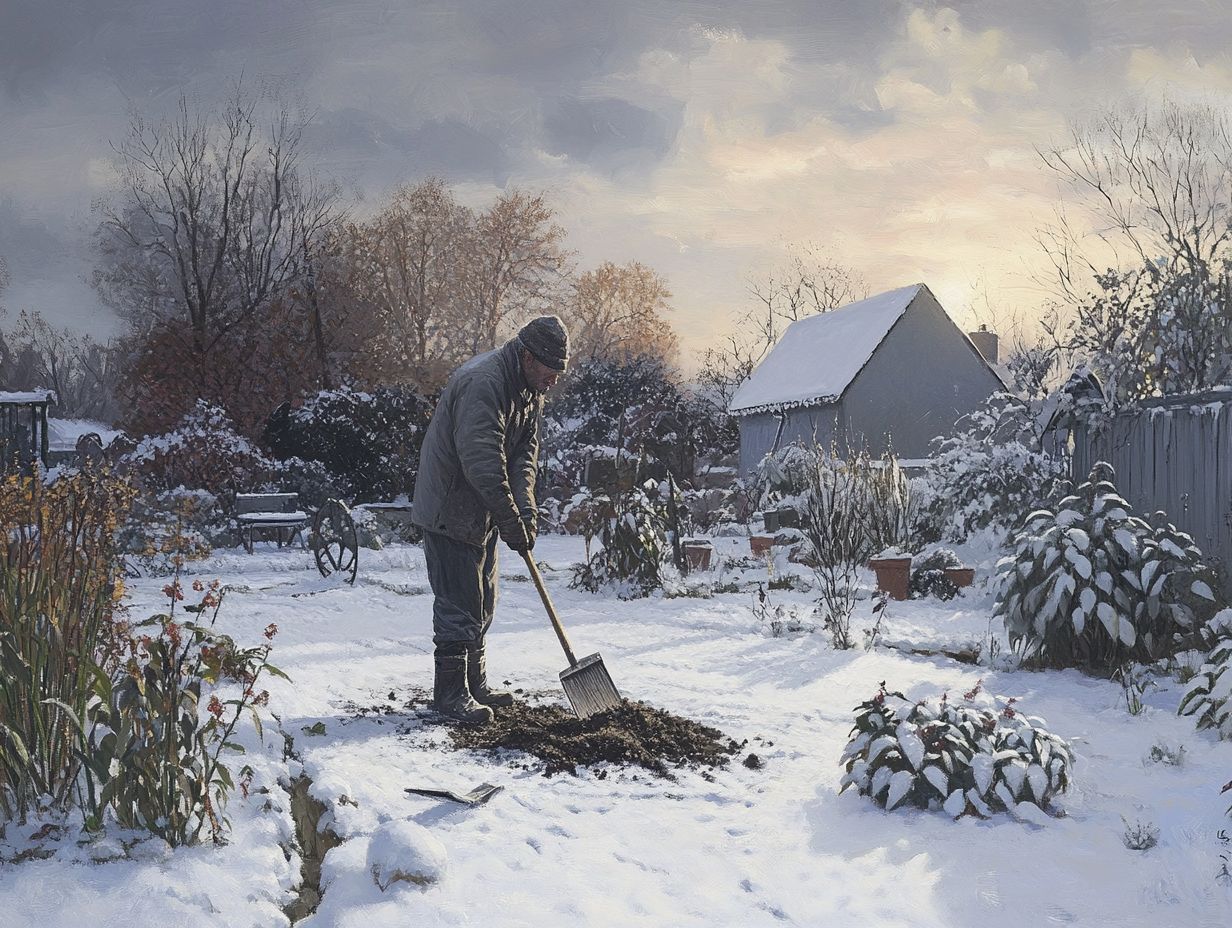
Applying effective techniques for how to prepare soil for winter planting during cold weather can significantly enhance its resilience and health. This paves the way for impressive results come spring.
By focusing on methods that secure warmth and moisture, you can cultivate a nurturing environment for the soil. Mulching stands out as an exceptional strategy; it acts as an insulating layer that prevents heat loss while simultaneously retaining moisture.
Incorporating organic materials like compost will bolster the soil structure and improve nutrient content. This aids in moisture retention. Planting cover crops serves a dual purpose: protecting the soil from erosion and enhancing microbial activity, ensuring a more fertile ground when the warmer months arrive.
Effective drainage practices complement these efforts and allow the soil to breathe while managing excess moisture. Embracing these techniques will set you up for a flourishing garden as the seasons change.
Common Mistakes to Avoid
Avoiding common mistakes in soil preparation is essential for maintaining soil health and ensuring a thriving garden, especially with winter on the horizon. Consider keeping your soil healthy in winter to support your gardening efforts.
Missteps like neglecting to amend the soil properly, failing to clear away debris, or overlooking the unique needs of different crops can lead to detrimental outcomes. These mistakes may result in poor growth and disappointing yields when spring finally arrives.
Potential Consequences of Poor Preparation
The consequences of inadequate soil preparation can be significant, affecting both the health of the soil and the yields you can expect during the growing season. When you overlook the essential steps of soil maintenance, you risk depleting vital nutrients. This can lead to a deficiency in the minerals necessary for optimal plant growth.
This neglect doesn t just compromise overall health; it also makes your crops more vulnerable to pests and diseases as they become weaker and less resilient. Without proper aeration making the soil loose so air can reach the roots and organic matter, your soil’s ability to retain moisture decreases, further hampering productivity. Ultimately, these mistakes can lead to disappointing harvests, resulting not only in financial strain but also in long-term damage to the land’s fertility.
Maintaining Soil Health Throughout Winter
Maintaining soil health throughout winter is essential for ensuring it remains fertile and primed for planting when spring arrives.
By implementing strategies to protect and nourish the soil such as applying organic mulch and regularly monitoring moisture levels you can significantly enhance its structure and nutrient availability.
Taking these proactive steps sets you up for healthier crops and bigger yields, setting the stage for a successful growing season.
Tips for Protecting and Nourishing Soil
Implementing specific strategies to protect and nourish your soil can significantly enhance its health during the winter months.
By incorporating organic materials such as compost and well-rotted manure, you can naturally enrich the soil, promoting a thriving ecosystem beneath the surface. Adding a layer of mulch not only helps retain moisture but also insulates the soil, preventing those annoying freeze-thaw cycles that can disrupt its structure.
Practices like cover cropping can shield your soil from erosion while boosting nutrient levels. When you till these crops back into the soil, you re returning valuable organic matter. Encouraging earthworms and beneficial microorganisms further supports soil integrity, ensuring it remains fertile and robust for the upcoming growing season.
Frequently Asked Questions

What are the best practices for soil preparation in winter?
The best practices for winter planting include adding organic matter, tilling the soil, and mulching to retain moisture and nutrients.
Why is it important to prepare soil in winter?
Preparing soil in winter is important because it allows nutrients to be replenished and moisture to be retained, especially when considering best practices for watering winter crops for the upcoming growing season.
Get started today to ensure your garden thrives next spring!
How can I add organic matter to my soil in winter?
Add organic matter to your soil in winter using compost, manure, or leaf mulch. These materials improve soil structure and provide important nutrients.
What is the best way to till soil in winter?
Till your soil in winter when the ground is slightly frozen. This helps prevent compaction and makes tilling easier.
Can I mulch my garden in winter?
Yes! Mulching your garden in winter insulates the soil and protects it from harsh temperatures.
How often should I water my garden in winter?
Water your garden about once a week during winter, depending on rainfall. This keeps the soil moist and prevents it from drying out.

